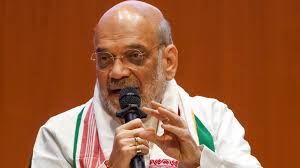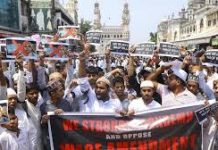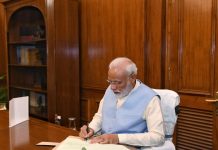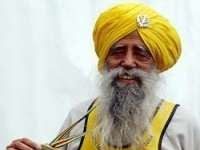The HM not only asserted that the NDA will complete its full five-year term but also predicted its re-run in 2029, with PM Modi at the helm. Was this an off-the-cuff remark, or is there a game plan?” by KUMKUM CHADHA

When Congress leader Salman Khurshid said that what is happening in Bangladesh “could happen in India” too, he went a bit too far.
Khurshid was referring to the anti-government protests that have rocked Bangladesh leading to the ouster of Prime Minister Sheikh Hasina.
While the stir was triggered by the job quota issue, it ended up demanding Hasina’s resignation.
Under attack was her dictatorial rule; her throwing political opponents in jail and crushing dissent. Such was the rage against her that irate mobs stormed her house, broke and looted whatever came their way.
Khurshid, it is clear, was trying to draw a parallel between India and Bangladesh. But to suggest that a duly elected government can be overthrown in India is a bit of a stretch.
There may be traces of authoritarian rule or attempts to quell dissent or even throw opponents in jail, but it would be foolhardy to suggest that India could see a repeat of Bangladesh.
In fact, it was Khurshid’s colleague, Shashi Tharoor, who put it in context. The larger message, Tharoor said, is about the importance of democracy and free and fair elections.
Events in Bangladesh that have unfolded in past weeks, particularly the ouster of Hasina, have compelled Indians to draw a parallel: If institutions were compromised in Bangladesh, dissent quelled, Opposition leaders jailed and a dictator breathing down the neck, then India has a similar script.
But the consequences are unlikely to be what Bangladesh has suffered: India is not Bangladesh; its people may take to the streets like they did during the farmers’ agitation but if given a choice, they would opt for the ballot rather than the bullet. Like, they would for democracy versus development.
It is well known that the Modi government in its last two terms launched a substantial number of schemes to help the poor, particularly women. But once the Opposition flagged the possibility of the BJP tinkering with the Constitution, people pitched for safeguarding democracy.
Similarly, Modi’s Bangladesh counterpart, Sheikh Hasina, had turned Bangladesh around and to quote her son, Sajeed Wazed, transformed it from a poor country to “one of the rising tigers of Asia”.
Yet in a toss-up between development and democracy, the people of Bangladesh chose democracy.
Parallels apart, what should one make of the googly bowled by Union Minister Amit Shah?
Barely has the government settled in after an election that Shah has sounded the 2029 bugle.
What exactly did Amit Shah say? He said that the NDA will not only complete its full five-year term but will also form the Government at the Centre in 2029.
Add to this, his assertion that Prime Minister Narendra Modi will be sworn in yet again, and the INDIA bloc parties should learn to work effectively as Opposition as they have a long innings to play; and the years from 2014 to 2024 deserve to qualify as the golden era in the country’s development history.
At this juncture, one needs to stop and ask: is this an off the cuff remark or is there a game plan? Had it been anyone other than Shah making it, one could have dismissed it as political rhetoric. But coming from Shah, one needs to go into the why and how of it.
Of course one explanation is that Shah was responding to the Opposition questioning the stability of the NDA government. Maybe, but did he have to go as far as 2029? Or anoint Narendra Modi as Prime Minister?
On the face of it, it could be wishful thinking: while the 2029 spiel may fit in, Narendra Modi as Prime Minister perhaps does not.
There could be several reasons for this: less substantiated but those that make more political sense.
On the 2029 return, everyone in the BJP who has a share in the power pie would like the Party’s come back yet again: the fourth time since the year 2000. On this the RSS, too, will be on the same page.
But as far as who will lead the pack, there are different views.
For starters, Modi himself may not pitch himself as a frontrunner knowing that the odds are stacked against him.
If the writing on the wall is any indication, then the countdown, both for the Party and Modi, has begun.
An astute politician that Modi is, he would leave nothing to chance. Nor would he want events to guide his Destiny or the RSS to force its hand.
It is no secret that the RSS would like to call the shots in governance. However, this is a tough call given that Modi is not a pushover.
Equally, the RSS is aware that Modi’s image has taken a hit and therefore this is the best time to move in and demand a pound of flesh.
In this context, it would not be wrong to say that while the results were a shocker for the Modi camp, for the RSS they were kind of good news.
It is no one’s case to suggest that the RSS wanted the saffron party to lose. Yet a fractured BJP and a weakened Modi is more than they could have asked for.
However, the RSS would not go for the kill. They would tread with caution and take one step at a time.
Rather than pushing out adversaries, the RSS would, as a first step, focus on pushing in some of their own to dominating positions.
No guesses for its frontrunners. The obvious names: Nitin Gadkari, Rajnath Singh and of course Uttar Pradesh Chief Minister Yogi Adityanath. How much the RSS is able to or how much would Modi let it, only Time will tell.
As of now, the immediate issue is to handpick the Party President. Even though J.P.Nadda is holding the reins, he is on borrowed time. His term ended in January this year.
With his new assignment as a Union Minister and Leader of the Upper House, he is kind of functioning as a part time Party Chief.
That said, it is crucial to decode Modi’s moves, strategy and future.
As for the future, the three-time Prime Minister would not wait to be elbowed out. He would rather carve a niche for himself and chalk out a meaningful role. This may translate into remaining relevant even while sacrificing day-to-day governance.
Would that mean that Modi would eye the office of President of India? Would it mean he would like to emerge as a world leader? Would it mean an Obama-like role who, even post-Presidency, has a say in the way things shape up in the United States?
Or nearer home, would Modi prefer to be like Sonia Gandhi, who even without a defined role virtually ran the UPA Government? Of course Mrs Gandhi’s advantage was a subservient Party and not a force like the RSS to contend with. In contrast Modi has an enemy within.
Irrespective, Modi is not a man who can be written off easily. Or one who will have the door shut on him.
If past events are any indication, he is unlikely to walk into the sunset. Or wait till 2029 for Shah’s prediction to take shape, if at all it will.
Modi is well aware that the clock is ticking and he is unlikely to let events overtake him. If anything, he would have a strategy in place before the enemy comes knocking.












